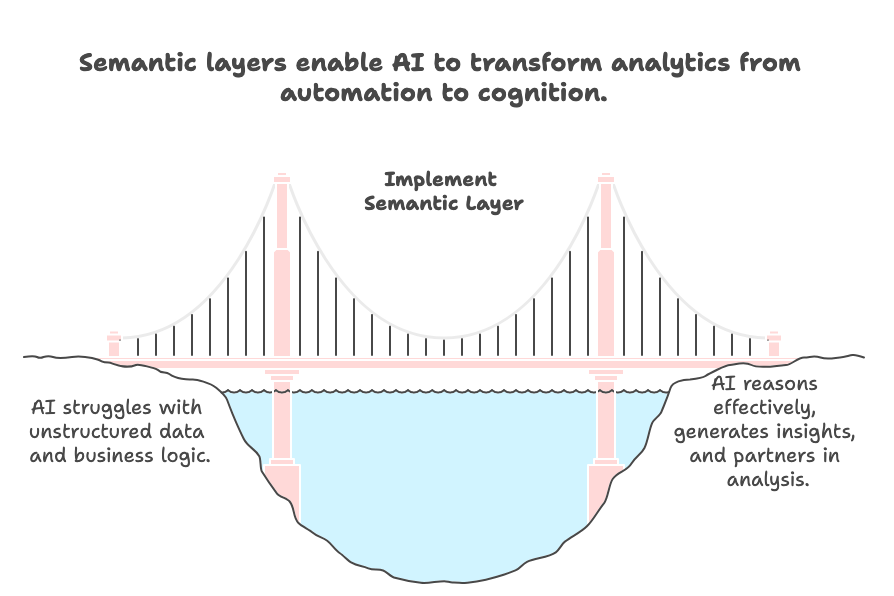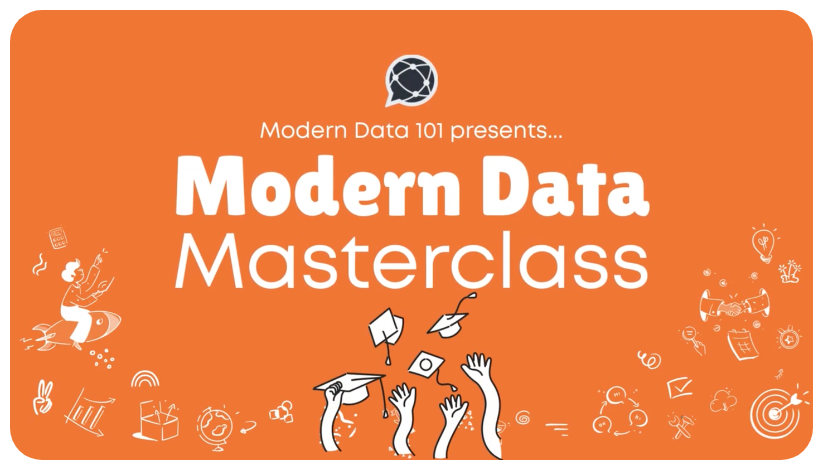The Semantic Bridge Between AI and Business Logic
Radically rethinking AI as "cognitive systems" instead of instruction-driven tools.
Before Diving in, The Modern Data Masterclass is Open!
Subscribers hear first 🧡
With our 10K milestone, we opened up The Modern Data Masterclass for all to tune in and find countless insights from top data experts in the field. We are extremely appreciative of the time and effort they’ve dedicately shared with us to make this happen for the community.
Dive in and also get a chance to nominate your favourite masterclass host!
Back to this week’s Deep Dive!
This piece is a community contribution from Bianca Nassif and Jeff Garcia, data leaders with complementary expertise in operations, BI, and analytics, working with Shearwater Data. Bianca, currently the Head of Operations, has led large-scale data transformations at UOL EdTech and Passei Direto, driving measurable impact through cost optimisation, team leadership, and advanced analytics strategy. Jeff is the Chief Executive Officer and brings over a decade of experience with prior leadership roles at Looker, Twisp, and Ayasdi, where he helped organisations harness modern BI. We’re thrilled to feature their unique insights on Modern Data 101!
We actively collaborate with data experts to bring the best resources to a 10,000+ strong community of data leaders and practitioners. If you have something to share, reach out!
🫴🏻 Share your ideas and work: community@moderndata101.com
*Note: Opinions expressed in contributions are not our own and are only curated by us for broader access and discussion. All submissions are vetted for quality & relevance. We keep it information-first and do not support any promotions, paid or otherwise!
Let’s Dive In
AI has been nothing short of a superpower for developers. Large Language Models (LLMs) and AI-native copilots like Cursor, GitHub Copilot, and Claude have transformed programming - automating boilerplate code, writing tests, and even assisting with architecture decisions.
The coding world has become significantly more efficient, with AI tools reducing much of the manual work that once slowed developers down.
But analytics hasn’t seen the same level of transformation (yet).
Despite the hype around AI and natural language querying, the field remains surprisingly manual for most companies. Why?
The Importance of Context in Analytics
Unlike programming, analytics isn’t just about writing code. It’s about understanding the business deeply enough to ask the right question and then translating that into a query that hits the right tables, respects governance rules, applies the correct filters, and surfaces results in a format that’s actually useful. Effective analytics depends more on contextual reasoning.
This is why LLMs have struggled to drive the same kind of lift in analytics. Natural language interfaces like ChatGPT can generate SQL, but unless the underlying business logic is explicitly modeled, the queries they produce are often wrong, incomplete, or misleading.
Why Analytics is Hard
Analytics is hard because the very foundation it operates on is messy, entangled, and human. That foundation is data. Unlike programming, where syntax is law and behavior is predictable, business data is a living artifact, shaped by teams, processes, and imperfect human decisions.
Metrics mutate depending on who measures them, where they are measured, and when. Churn isn’t churn everywhere, revenue isn’t revenue everywhere. The same term can hold different truths in different contexts, and a naive AI cannot reconcile this unless the logic behind it is explicitly codified.
The second difficulty is that business logic is rarely written down in a machine-readable form. It floats in slide decks, in tribal knowledge, in spreadsheets whose formulas are decades old and poorly documented. It is implicit by nature, and AI that lacks visibility into these implicit rules will, at best, approximate answers, and at worst, mislead decision-making. The problem isn’t computational capacity; it is a lack of structure.
Finally, analytics isn’t just retrieval. It is reasoning layered atop causality, assumptions, and trade-offs. Every insight carries context: the story behind the number, the dependencies between metrics, and the constraints of the business environment. For AI to participate meaningfully, it must not merely fetch data, it must navigate these layers, understand them, and reason within them.
AI needs 1/ structured representations of business logic, 2/ curated access to reliable data, and 3/ a framework to reason over context.
How to Effectively Use AI for Analytics
The key to enabling AI in analytics isn’t better prompts. It’s better context, and that’s where semantic layers come in.
Semantic Layers
Whether in tools like Looker, dbt, or Omni, acts as the connective tissue between raw data and business meaning. They encode dimensions, measures, joins, access controls, and documentation in code.
This structure not only serves human analysts, it gives AI agents the metadata and surface area they need to generate useful, accurate outputs.
We’re investing heavily in helping agents reason through data by giving them programmatic access to these semantic layers. When agents can work with tools that describe how revenue is defined, how churn is calculated, and how customer segments are modeled, they can do far more than generate SQL. They can deliver real analysis.

A quick revisit to an excerpt from Frances O’Rafferty on Modern Data 101 ⬇️
What is a Semantic Layer?
The semantic layer is a virtual layer that sits between the Physical Layer (data sources) and the consumption tooling. It provides a common business representation of the data, abstracting the complexities of the underlying data sources.
The Semantic Layer translates the physical data into the launguage of your business.
Back in the world of Business Objects, the semantic layer served as a foundational component where JOINs between tables were created, measures and dimensions were defined and organised into subject area folders.
This allowed users to seamlessly create reports by dragging and dropping measures and dimensions from a list of logically grouped attributes. The SQL was then generated and executed on demand to produce the report. However, the downside is that all this knowledge is locked into the Business Objects stack and not shared outside the vendor’s tool.
This is still a problem for many tools today where we define the semantics within the consumption mechanism. By doing this, we are losing the opportunity to drive consistency in the way we describe data across the enterprise.
When we talk about the semantic layer today, we are considering Metadata, Business Glossary, Data Models (Logical, Ontology, & Knowledge graphs), Access Control and Taxonomies.
The semantic layer is pivotal in bridging the divide between intricate data sources and user-friendly consumption tools. The semantic layer’s evolution should be a dynamic two-way conversation that adapts to changes in both the physical data and the consumption tools.
—end of excerpt—
📝 Related Reads
➡️ How to avoid Semantic Mistrust
➡️ The Reverse Path: How Data Products also fortify semantics/context
➡️ Adopting Isolated Semantic Tooling versus Adopting an Interoperable Semantics Layer integrated with Data Products and Existing Data Stack
A Radical Rethink: AI as Analytics Partner, Not Just a Tool
At its core, analytics is reasoning over the world as it is. To treat AI as a tool is to misunderstand its potential. The real opportunity lies in leveraging AI as a partner: an entity that can
internalize the rules of your business,
understand the subtleties of your metrics, and
participate in the act of insight generation.
With a semantic layer as its foundation, AI stops guessing and starts reasoning. It can traverse dimensions, explore hypotheses rooted in actual business logic, and test scenarios against the scaffolding of your defined metrics. It can evaluate the ripple effects of changes in KPIs, illuminate the hidden causes behind variance, and even help construct complex formulas that might have seemed opaque before.
AI as a reasoning engine turns analytics into an ecosystem rather than a pipeline.
It surfaces patterns that humans might overlook, proposes avenues of inquiry that had never occurred to your team, and continuously refines its understanding in dialogue with the data.
The eccentric charm of this approach is that we are no longer training AI to follow instructions. We are teaching it to think in a way that mirrors the contours of our business reality. In doing so, we move from automation to cognition, from code generation to insight generation, and from static dashboards to a living, reasoning analytic mind.
Driving AI in Analytics with Semantic BI tools
If you want AI to meaningfully support your analysts, the path is clear: move your data stack to code.
Traditional BI tools can be user-friendly, but they are a dead end for AI. Without a semantic layer, they leave behind no audit trail, no structured metadata, and no clear representation of business logic. There’s nothing for an AI system to reason over.
Semantic-layered BI tools, on the other hand, provide a structured, code-based map of your metrics, dimensions, and data relationships. They turn business logic into something both analysts and AI agents can understand, reuse, and build upon.
The more of your logic you encode in tools like these, the more capable your AI agents become.
Advantages of The BI-Integrated Semantic Layer
1. Business logic transparency
Analysts can clearly see and audit the metrics and measures in one place. You can also immediately test changes and see how it plays out in the end products (dashboards and self-service reporting environments) without leaving the tool.
2. Optimized query performance
It’s possible to cache, pre-aggregate, or push down optimized queries, reducing computing costs.
3. Faster iteration & business user autonomy
It is much closer to the business teams and subject matter experts. There ends up being more fidelity between what the business needs and how the data model is defined. If the semantic model is further upstream, it’s easier to have a disconnect between subject matter experts and data engineering teams.
4. Built-in security, access control, and governance
Provide row-level security (RLS) and role-based access control (RBAC).
Once your business logic is structured and accessible,
AI can begin to take on truly meaningful tasks in analytics.
Agents will move beyond simple SQL generation to:
Explore hypotheses based on business context
Evaluate changes in key performance indicators (KPIs)
Explain variance and uncover root causes
Assist in building and validating complex formulas
Access and combine data across multiple dimensions seamlessly
That’s the future we believe for an effective AI strategy applied in Analytics.
Move your business logic to code. Structure your data with semantic layers. And give AI the context it needs to stop guessing and start reasoning.
MD101 Support ☎️
If you have any queries about the piece, feel free to connect with the author(s). Or feel free to connect with the MD101 team directly at community@moderndata101.com 🧡
Author Connect 🖋️
Find me on LinkedIn 🙌🏻
Find me on LinkedIn 🤝🏻
From MD101 🧡
The Modern Data Masterclass: By the Community, For the Community
Master Data, One Masterclass at a Time! Learn from Top Data Gurus in the community. Free access to countless perspectives.




Excellent thank you !
Love your thesis here.
Q: Let's say I've followed it completely and pushed all business logic and semantic mapping down into the database. People can use the data without needing to map data or add any logic. Is there an AI tool that can navigate this better than the analyst?
Thank you for the article!
ZH